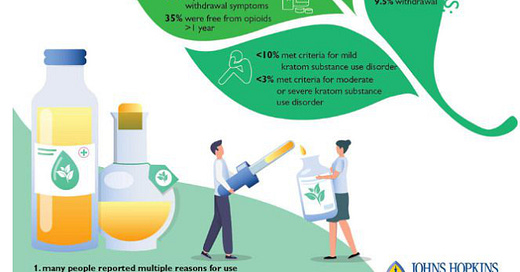Over 50 million American adults grapple with the daily challenges of debilitating chronic pain.
From the unrelenting agony of lower back pain, arthritis, fibromyalgia, and conditions like endometriosis or Polycystic Ovary Syndrome (PCOS) to grueling headaches, cancer pain, and neurogenic pain, the sources of chronic pain are diverse.
Yet, the result is always the same — a life where your body turns into a relentless adversary and everyday tasks become an uphill battle.
Living with chronic pain makes symptom relief a focal point and a source of hope.
While numerous ways to manage chronic pain exist, a whopping 20 percent of Americans living in pain turn to prescription opioids for relief. That’s not ideal. Beyond their powerful pain-relief properties, opioids like oxycodone, hydrocodone, and fentanyl carry a strong potential for addiction and unleash a cascade of daily side effects. Drowsiness, dizziness, constipation, muscle rigidity and jerks, and a dysfunctional immune system are just the beginning.
Unfortunately, the longer you continue to rely on opioids, the higher the risk of experiencing serious side effects. The longer you use opioids, the higher the odds that you’ll see your form of relief and chronic pain in a similar light — as something you desperately want to break free from.
If you’re looking for an alternative way to manage your chronic pain, one term may repeatedly catch your attention: Kratom.
With its centuries-long history as a trusted pain reliever in South Asia, this plant has been curious worldwide in recent years. What is Kratom, though, and what should you know if you’re exploring it as an opioid alternative?
What Is Kratom?
Kratom, scientifically called Mitragyna speciosa, is a beautiful, lush southeast to Southeast Asia. Native to Thailand, Myanmar, Malaysia, Papua New Guinea, and Indonesia, it’s related to the coffee plant.
Historically used to brew tea, chew, and smoke, people living in Kratom’s native regions have been using its leaves as a medicinal preparation for centuries. Active ingredients like mitragynine and 7-hydroxymitragynine give Kratom leaves stimulant and analgesic properties, making it a uniquely interesting plant for recreational and medicinal uses alike.
Kratom has risen in popularity in Western countries, including the United States and the United Kingdom, in recent years — drawing the attention of scientists, policymakers, health authorities, and even the DEA, which insists Kratom has no legitimate therapeutic use. Emerging research disagrees, but people interested in exploring the pain management benefits should know that Kratom has been banned in several US states while remaining legal in most.
How Does Kratom Help with Chronic Pain?
Millions of satisfied Kratom consumers have, alongside new scientific interest, shed light on the plant’s benefits in managing chronic pain. The secret ultimately lies in Kratom’s unique blend of analgesic (pain relief) and stimulant properties:
· Although Kratom is not an opioid, it activates both opioid receptors and other receptors in the body. The result is that these receptors “absorb” the pain before it can reach the brain — where you would become aware of it.
· Kratom doesn’t just “cancel out” active sources of pain. It also acts as an anti-inflammatory, helping sources of inflammation settle down and preventing flare-ups.
· Kratom relaxes the muscles, which offers another source of pain relief in people with muscle-related conditions.
· The stimulant properties of Kratom do several things. Increasing motivation and energy is one critical effect; with a little extra help, people living with chronic pain will feel more able to complete necessary daily tasks.
· Kratom also benefits people with chronic pain for the same reason the tropical plant helps those with mental health conditions like depression and anxiety. Thanks to its stimulant properties, Kratom boosts your mood — a welcome relief when you’re burdened by chronic pain.
Why Is Kratom a Safer Alternative to Opioids?
Kratom, traditionally chewed, made into tea, or prepared to form a paste, is now usually powdered and added to convenient capsules. While it has some addictive potential — which consumers with a history of opioid addiction should be mindful of — it is physically difficult to overdose on Kratom. When your body has had enough, it will tell you to stop — plain and simple.
Although Kratom can be habit-forming, it does not cause severe withdrawal symptoms that require medical attention, a big reason health and drug authorities haven’t had much success in trying to ban it. (In fact, Kratom has a long history of being used as an opium addiction treatment in its native regions — with excellent success rates. An ancient and much safer version of methadone?)
Think of Kratom as a broad-spectrum pain reliever — by acting on different receptors within your body, it provides more effective pain relief that allows you to manage your pain with a much lower dose.
Another plus? A more modest spectrum of side effects compared to opioids. People taking high doses of Kratom may experience some dizziness, fatigue, and muscle weakness. Kratom can also induce nausea and vomiting when you overdo it. As you learn the appropriate dose for your situation, you can avoid these adverse effects with time.
Kratom Testimonials
A Final Word
Countless public health authorities have tried (and failed) to make people with chronic pain very afraid of Kratom, but the science is on this plant’s side — along with, in most cases, its legality.
Whether you have become addicted to opioids and are looking for a way out or you are committed to managing your chronic pain naturally, Kratom can help. It’s best used under the supervision of a healthcare professional intimately familiar with its true power and may prove to be a total game-changer that gives you your life back.







Near infrared light from the Sun, and saunas is fantastic pain reliever as well as it activates daytime/ subcellular melatonin:
https://romanshapoval.substack.com/p/how-to-treat-emf-radiation-part-1